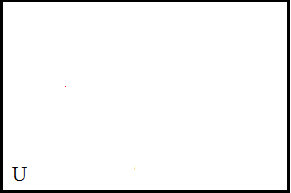
 .]
Just as we use ∈ to mean "is in", we use ∉ to mean "is not in", or "is not a member of" or
"is not an element of" or "is not contained in".
.]
Just as we use ∈ to mean "is in", we use ∉ to mean "is not in", or "is not a member of" or
"is not an element of" or "is not contained in".
| In an effort to make this page a bit more helpful, many of the following sets are created anew each time this page is loaded. Thus, when the page is reloaded you will find that the sets have changed and as such the examples change, thus providing you with new examples of the points being illustrated. |
When we use an ellipsis to show that we are "implying some unlisted elements" of the set we must be sure that we have established a clear pattern for the set. Consider two more examples. First we have the set D given as
All of the sets so far have been "finite" sets. It has been possible, though perhaps inconvenient, to list all of the elements of the set. Even a really large finite set can be specified as a listing. Thus, we could have the set recognizing that F = G for those sets.
However, there is nothing that says a set must be finite. We could have the set
In the previous examples we have used the initial elements in the listing of the set to set the pattern. This need not be the case. We could just as easily have used the final elements in the set listing to demonstrate the pattern. For example, we could have constructed the set
We can use the same technique to have a set listing for an infinite set where the set listing starts with the ellipsis. For example, consider the set
Besides "listing" the elements of a set, we also have a way to just specify the "rule" that we will use to determine if something is or is not an element of the set. We do this via the "set builder" notation. For example, we could write You might have noticed that in set N we specified x ∈ Z rather than just saying x. We did this so that it was clear that we were only interested in integer values. We could have put that restriction on either side of the vertical bar. Thus, we could have just as easily specified set N as In set builder notation it is important to specify a rule that allows the reader to determine whether or not something is or is not an element of the set.
| Table I | |
Earlier we noted that we often use capital letters to name
sets. As a consequence, we find ourselves reusing those letters for different sets.
The examples given above have served their purpose. Starting at here we have new sets to
consider. They are
|
|
B ⊆ A D ⊆ A D ⊆ C E ⊆ C F ⊆ C |
G ⊆ C E ⊆ G F ⊆ G E ⊆ F F ⊆ E |
Interestingly enough, we can read the statement B ⊆ A backwards, that is right to left, as "A is a superset of B", meaning that A contains all of the elements of B. Just to make life a bit more complicated we have a different symbol, ⊇ that can be read left to right as "is a superset of", as in A ⊇ B, or we can read that right to left as B is a subset of A.
We note that both E ⊆ F and E ⊆ G are true. However, we should be able to differentiate these cases in that G has at least one element, in our example that is 11, that is not in E. In particular, we have that 11∈G but 11∉E. We make such a differentiation by saying "E is a proper subset of G". We even have a symbol, ⊂, to express "is a proper subset of". Thus, when we say B ⊂ A we mean that every element of B is also an element of A and A has at least one element that is not an element of B.
For a moment, let us return to the case of sets E and F. We know that all three of the following statements are true:
| As a small aside, in English we often use the word "or" in an exclusive sense. For example, when shopping with my young son I might say, "you can have a candy bar or an ice cream bar." We all understand that such a statement is not an offer to have both of them. That is an "exclusive or", and in mathematics we write that as "xor" to differentiate it from the "inclusive or" which we write as "or". |
| Proof that S∪T = T∪S | ||
| Part I: show that
S∪T ⊆ T∪S
Let x ∈ S∪T, then there are three possible cases: | ||
| Case I: x ∈ S but x ∉ T | Case II: x ∉ S but x ∈ T | Case I: x ∈ S and x ∈ T |
| then x ∈ S so x ∈ T∪S
Therefore, S∪T ⊆ T∪S |
then x ∈ T so x ∈ T∪S
Therefore, S∪T ⊆ T∪S |
then x ∈ S so x ∈ T∪S
Therefore, S∪T ⊆ T∪S |
| Conclusion of Part I: in all cases S∪T ⊆ T∪S | ||
| Part II: show that
T∪S ⊆ S∪T
Let x ∈ T∪S, then there are three possible cases: | ||
| Case I: x ∈ S but x ∉ T | Case II: x ∉ S but x ∈ T | Case I: x ∈ S and x ∈ T |
| then x ∈ S so x ∈ S∪T
Therefore, T∪S ⊆ S∪T |
then x ∈ T so x ∈ S∪T
Therefore, T∪S ⊆ S∪T |
then x ∈ S so x ∈ S∪T
Therefore, T∪S ⊆ S∪T |
| Conclusion of Part II: in all cases T∪S ⊆ S∪T | ||
| We have shown that S∪T ⊆ T∪S and T∪S ⊆ S∪T , therefore S∪T = T∪S | ||
The following table, Table II, gives us some new sets to consider. The table goes on to give us examples of finding the union of each pair of sets. The elements of each set change whenever this page is reloaded.
|
A word of caution. One of the more common "trick" questions is to falsely suggest {∅} is the empty set.
Remember that a set is a collection of "things". One such "thing" could be the empty set. This,
the set {∅} is the set that contains one thing and that one thing is the empty set. Since the
empty set has nothing in it and the set {∅} has one thing in it, the two sets are not identical.
We would write this as
|
The empty set has a special relation with the operation of union, namely, the result of the union of any set and the empty set is that original set. Using symbols, we say that for any set T
This does give us a moment of thought. Since ∅ is the identity element for the operation of union, is there an identity element for the operation of intersection? In symbolds, if we have any set T is there some set which we will call M such that
Having defined that universal set, it is essential that we realize that we could have defined a different universal set, say,
Let us continue this discussion using the sets of Table I and the universal set defined as
| Table III | ||
A repeat of Table I with the understanding that the universal set is
|


| Table V new set definitions to use below |
|
U = { 1, 2, 3, ..., 23, 24, 25 } A = { 1, 2, 3, 4, 5, 6, 7, 8 } B = { 3, 4, 5, 6, 9, 10, 11, 12 13, 14 } C = { 5, 6, 7, 14, 15, 16, 17 } D = { 18, 19, 20, 21 } E = { 11, 12 } |

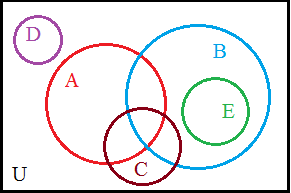
As noted above, we can use these Venn diagrams to "see" why a property such as
|
Here is the Venn diagram of the sets A and B from Table V. |

|
|
The shaded portion of the image represents A ∪ B. |
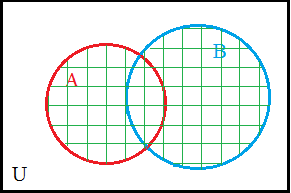
|
|
The filled region represents the complement (A ∪ B)'. |
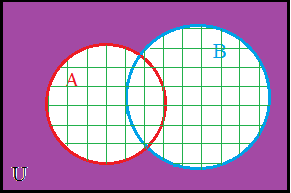
|
|
Shading both A', via the region with vertical lines, and B', via the region with horizontal lines. |

|
|
Filling in the region corresponding to A' ∩ B'. |
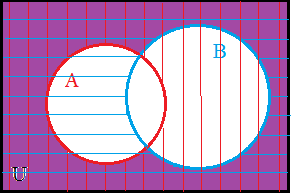
|
The other equality given above was
|
In this figure we have shaded set A with horizontal lines and set B with vertical lines. Thus, the doubly shaded region represents the intersection, (A ∩ B) |
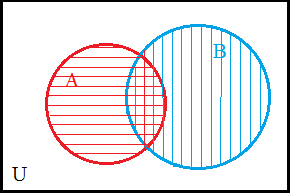
|
|
Here we look at just the intersection, (A ∩ B). |

|
|
Here we have filled the rest of the diagram to indicate the region (A ∩ B)'. |
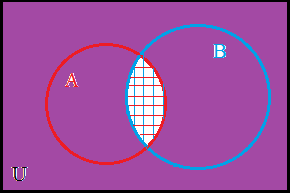
|
Now we can return to look at the left side of the equality, namely, A' ∪ B' To do this we first identify the two regions, A' and B' .
|
The complement of A is shaded with vertical lines and the complement of B is shaded with horizontal lines. |

|
|
Filling all areas that were shaded in Figure 9 gives us te union of those two areas. Thus, Figure 10 represents A' ∪ B'. |
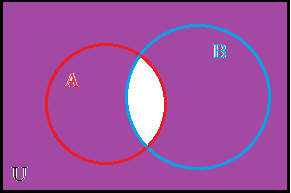
|
We have a way to indicate the cardinality of a set, namely,
| Table VI | |
| U = { 1, 2, 3, ..., 23, 24, 25 } | n(U) = 25 |
| A = { 1, 2, 3, 4, 5, 6, 7, 8 } | n(A) =8 |
| B = { 3, 4, 5, 6, 9, 10, 11, 12 13, 14 } | n(B) = 10 |
| C = { 5, 6, 7, 14, 15, 16, 17 } | n(C) = 7 |
| D = { 18, 19, 20, 21 } | n(D) = 4 |
| E = { 11, 12 } | n(E) = 2 |
©Roger M. Palay
Saline, MI 48176
April, 2015